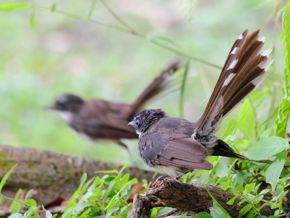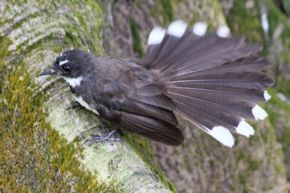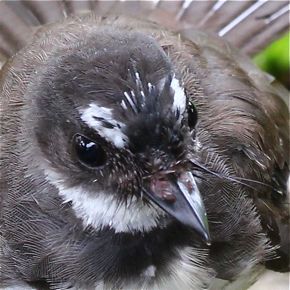“The Pied Fantail (Rhipidura javanica) is a hyperactive bird that rarely stays still. During foraging, it is on the move constantly, flitting from place to place. From time to time, it likes to cock its tail and down-stretch its wings. It is delightful to watch the display of its famous fanned tail feathers (above). Needless to say, that is how it got its name.
“My previous experience with Pied Fantails was that they were rather skittish and usually under cover of vegetation. Thus, I was glad to encounter a few Pied Fantails that were not so shy and stayed in open view that day.
“A pair was seen foraging in the canopy of a cluster of trees. Never staying still, they were seen constantly flitting from stem to stem looking for insects amongst the foliage (above right). One of them descended onto the ground and was stalking something near the bottom of a tree trunk. In a flash, it caught a dragonfly and flew up to perch on a branch (above left). The prey was bashed furiously before disappearing into the oral cavity of the fantail.
“At another location, another pair was encountered foraging. Likewise, they were moving constantly; flitting around. But, this time they were at the base of a tree, on the ground, and on the exposed roots. This was a fig tree, and it was fruiting at that time. Starlings, barbets and doves were harvesting figs in the canopy. Apparently, the fantails were only interested in insects that were nearer the ground. So engrossed were they catching insects that they were oblivious to my presence. One of the fantails was at times just a metre and a half from me. It was the closest that I have encountered with this species.
“At such close distance, I was able to see one of the fantails with sign of moulting on its forehead (left). There were quite a few pin feathers that could be seen. Though not as extensive as in the balding mynas that had been posted earlier, this could be evidence that such moulting may be more prevalent and may be occurring in more species than previously thought.”
Kwong Wai Chong
Singapore
15th October 2010













